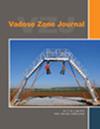确定砂土中特定空气-水界面面积的传粉函数:基于孔隙网络的多基因遗传编程方法
IF 2.8
3区 地球科学
Q3 ENVIRONMENTAL SCIENCES
引用次数: 0
摘要
了解比空气-水界面面积(SAWIA)对于描述和模拟含水层水文学中的各种现象(如病毒和胶体迁移、污染物溶解、蒸发以及非饱和土壤的水力学行为)至关重要。传统的测量方法(包括 X 射线成像和示踪技术)经常会遇到困难,导致为 SAWIA 提供可靠关系的研究很少。目前,还没有文献利用中值粒度和孔隙度等易于测量的土壤特性将 SAWIA 与饱和度和吸力联系起来。在这项研究中,我们首先开发了一种能够预测 SAWIA 的孔隙网络模型,将其与相应的土壤水滞留曲线(SWRCs)进行校准。然后,我们利用这些模型为六种砂质土壤编制了一个全面的 SAWIA 数据库,这些土壤的试验性 SWRCs 涵盖了一系列中值粒度和孔隙率。利用该数据库,我们通过多基因遗传编程建立了一个土壤转移函数。该函数的准确性是根据之前未用于其训练和测试的实验数据进行验证的。我们的参数研究表明,孔隙率或中值粒度的增加会导致饱和度和吸力方面表现出较高 SAWIA 的区域减少。本文章由计算机程序翻译,如有差异,请以英文原文为准。
Determination of a pedotransfer function for specific air–water interfacial area in sandy soils: A pore network‐informed multigene genetic programming approach
Understanding specific air–water interfacial area (SAWIA) is essential for characterizing and modeling various phenomena in vadose zone hydrology, such as virus and colloid transport, contaminant dissolution, evaporation, and the hydro‐mechanical behavior of unsaturated soils. Traditional measurement methods, including X‐ray imaging and tracer techniques, often encounter challenges, leading to a scarcity of studies that provide a reliable relationship for SAWIA. Currently, no pedotransfer function in the literature links SAWIA with saturation and suction using readily measurable soil properties such as median grain size and porosity. In this study, we initially developed a pore network model capable of predicting SAWIA by calibrating it with corresponding soil‐water retention curves (SWRCs). We then used these models to compile a comprehensive database of SAWIA for six sandy soils, for which experimental SWRCs were available, covering a range of median grain sizes and porosities. Utilizing this database, we established a pedotransfer function through multigene genetic programming. The accuracy of this function was validated against experimental data not previously used in its training and testing. Our parametric study indicated that increases in either porosity or median particle size led to a decrease in the regions exhibiting higher SAWIA in terms of saturation and suction.
求助全文
通过发布文献求助,成功后即可免费获取论文全文。
去求助
来源期刊

Vadose Zone Journal
环境科学-环境科学
CiteScore
5.60
自引率
7.10%
发文量
61
审稿时长
3.8 months
期刊介绍:
Vadose Zone Journal is a unique publication outlet for interdisciplinary research and assessment of the vadose zone, the portion of the Critical Zone that comprises the Earth’s critical living surface down to groundwater. It is a peer-reviewed, international journal publishing reviews, original research, and special sections across a wide range of disciplines. Vadose Zone Journal reports fundamental and applied research from disciplinary and multidisciplinary investigations, including assessment and policy analyses, of the mostly unsaturated zone between the soil surface and the groundwater table. The goal is to disseminate information to facilitate science-based decision-making and sustainable management of the vadose zone. Examples of topic areas suitable for VZJ are variably saturated fluid flow, heat and solute transport in granular and fractured media, flow processes in the capillary fringe at or near the water table, water table management, regional and global climate change impacts on the vadose zone, carbon sequestration, design and performance of waste disposal facilities, long-term stewardship of contaminated sites in the vadose zone, biogeochemical transformation processes, microbial processes in shallow and deep formations, bioremediation, and the fate and transport of radionuclides, inorganic and organic chemicals, colloids, viruses, and microorganisms. Articles in VZJ also address yet-to-be-resolved issues, such as how to quantify heterogeneity of subsurface processes and properties, and how to couple physical, chemical, and biological processes across a range of spatial scales from the molecular to the global.
 求助内容:
求助内容: 应助结果提醒方式:
应助结果提醒方式:


